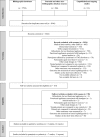Long-term effects of functional appliances in treated versus untreated patients with Class II malocclusion: A systematic review and meta-analysis
- PMID: 31490945
- PMCID: PMC6730901
- DOI: 10.1371/journal.pone.0221624
Long-term effects of functional appliances in treated versus untreated patients with Class II malocclusion: A systematic review and meta-analysis
Abstract
Objective: To assess the cephalometric skeletal and soft-tissue of functional appliances in treated versus untreated Class II subjects in the long-term (primarily at the end of growth, secondarily at least 3 years after retention).
Search methods: Unrestricted electronic search of 24 databases and additional manual searches up to March 2018.
Selection criteria: Randomised and non-randomised controlled trials reporting on cephalometric skeletal and soft-tissue measurements of Class II patients (aged 16 years or under) treated with functional appliances, worn alone or in combination with multi-bracket therapy, compared to untreated Class II subjects.
Data collection and analysis: Mean differences (MDs) and 95% confidence intervals (95% CIs) were calculated with the random-effects model. Data were analysed at 2 primary time points (above 18 years of age, at the end of growth according to the Cervical Vertebral Maturation method) and a secondary time point (at least 3 years after retention). The risk of bias and quality of evidence were assessed according to the ROBINS tool and GRADE system, respectively.
Results: Eight non-randomised studies published in 12 papers were included. Functional appliances produced a significant improvement of the maxillo-mandibular relationship, at almost all time points (Wits appraisal at the end of growth, MD -3.52 mm, 95% CI -5.11 to -1.93, P < 0.0001). The greatest increase in mandibular length was recorded in patients aged 18 years and above (Co-Gn, MD 3.20 mm, 95% CI 1.32 to 5.08, P = 0.0009), although the improvement of the mandibular projection was negligible or not significant. The quality of evidence was 'very low' for most of the outcomes at both primary time points.
Conclusions: Functional appliances may be effective in correcting skeletal Class II malocclusion in the long-term, however the quality of the evidence was very low and the clinical significance was limited.
Systematic review registration: CRD42018092139.
Conflict of interest statement
The authors have declared that no competing interests exist.
Figures







Comment in
-
Functional Appliances May Be Effective in Correcting Skeletal Class II Malocclusion in the Long Term; However, the Quality of the Evidence Was Very Low and the Clinical Significance Was Limited.J Evid Based Dent Pract. 2020 Jun;20(2):101436. doi: 10.1016/j.jebdp.2020.101436. Epub 2020 Apr 10. J Evid Based Dent Pract. 2020. PMID: 32473805
Similar articles
-
Precision wings treating skeletal class II in growing patients: a systematic review and meta-analysis.Prog Orthod. 2025 May 26;26(1):16. doi: 10.1186/s40510-025-00564-4. Prog Orthod. 2025. PMID: 40415149 Free PMC article. Review.
-
One phase or two phases orthodontic treatment for Class II division 1 malocclusion?Evid Based Dent. 2019 Jun;20(2):56-57. doi: 10.1038/s41432-019-0035-4. Evid Based Dent. 2019. PMID: 31253968
-
What evidence exists for myofunctional therapy with prefabricated appliances? A systematic review with meta-analyses of randomised trials.J Orthod. 2019 Dec;46(4):297-310. doi: 10.1177/1465312519880558. Epub 2019 Oct 10. J Orthod. 2019. PMID: 31597520
-
Incremental or maximal mandibular advancement in the treatment of class II malocclusion through functional appliances: A systematic review with meta-analysis.Orthod Craniofac Res. 2020 Nov;23(4):371-384. doi: 10.1111/ocr.12388. Epub 2020 May 29. Orthod Craniofac Res. 2020. PMID: 32390332
-
Removable functional appliances effective in patients with Class II malocclusions.Evid Based Dent. 2016 Mar;17(1):27-8. doi: 10.1038/sj.ebd.6401156. Evid Based Dent. 2016. PMID: 27012576
Cited by
-
Characteristics of craniofacial morphology and factors affecting them in patients with isolated cleft palate.PeerJ. 2021 Apr 20;9:e11297. doi: 10.7717/peerj.11297. eCollection 2021. PeerJ. 2021. PMID: 33976983 Free PMC article.
-
Mandibular Endochondral Growth Is Specifically Augmented by Nutritional Supplementation with Myo-Inositol Even in Rabbits.Dent J (Basel). 2024 Feb 26;12(3):49. doi: 10.3390/dj12030049. Dent J (Basel). 2024. PMID: 38534273 Free PMC article.
-
A comparative three-dimensional analysis of skeletal and dental changes induced by Herbst and PowerScope appliances in Class II malocclusion treatment: a retrospective cohort study.Prog Orthod. 2025 Jul 3;26(1):24. doi: 10.1186/s40510-025-00571-5. Prog Orthod. 2025. PMID: 40608270 Free PMC article.
-
Orthodontic Management of Skeletal Class II Malocclusion with the Invisalign Mandibular Advancement Feature Appliance: A Case Report and Review of the Literature.Case Rep Dent. 2022 May 13;2022:7095467. doi: 10.1155/2022/7095467. eCollection 2022. Case Rep Dent. 2022. PMID: 35601082 Free PMC article.
-
Proposal of Dental Hygiene Diagnosis for Cancer Patients Based on Dental Hygiene Process of Care in Acute Care Hospitals: A Narrative Review.Healthcare (Basel). 2020 Jul 18;8(3):217. doi: 10.3390/healthcare8030217. Healthcare (Basel). 2020. PMID: 32708439 Free PMC article. Review.
References
Publication types
MeSH terms
LinkOut - more resources
Full Text Sources
Medical
Research Materials
Miscellaneous

